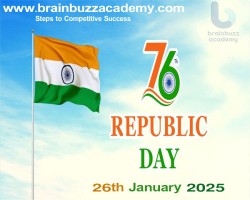UPSC Current Affairs
| Important Days |
|---|
|
|
|
Context:
Every year, Republic Day is marked on January 26. In 2025, India is celebrating its 76th Republic Day. On this day, the Constitution of India was adopted, and our country became a Republic. Republic Day 2025 theme: The theme of Republic Day 2025 is Swarnim Bharat – Virasat aur Vikas' (Golden India – Heritage and Development), reflecting India's rich cultural heritage and its ongoing journey of progress. Republic Day 2025 chief guest: Indonesian President Prabowo Subianto will be the chief guest for Republic Day 2025, marking a significant milestone in the 75th anniversary of diplomatic relations between India and Indonesia. Republic Day significance: The significance of Republic Day is multifaceted. First, it highlights the commitment to constitutional values: it reflects India's commitment to democratic ideals of justice, liberty, equality, and fraternity. It is also a celebration of India's cultural heritage. The cultural events and tableaux presented during the celebrations showcase India's rich cultural diversity. Another major highlight of the national holiday is the promotion of national unity as the celebrations promote unity in diversity, highlighting India's strength in its diversity. Republic Day also pays tribute to and honours the valour and sacrifice of the leaders and freedom fighters who helped India become independent and build a republic. What is the History of Republic Day? About: Republic Day commemorates the adoption of the Constitution of India on 26th January 1950, and the country’s transition to a republic which came into effect on 26th January 1950. The constitution was adopted by the Constituent Assembly of India on 26th November 1949 and came into effect on 26th January 1950. The Constitution of India repealed the Indian Independence Act 1947 and Government of India Act 1935 when it became effective on 26th January 1950. India ceased to be a dominion of the British Crown and became a sovereign, democratic republic with a constitution. History: Declaration of Poorna Swaraj: The Lahore Session of the INC in December 1929 passed the historic "Poorna Swaraj" resolution, calling for total self-rule/sovereignty and complete independence from British rule. The Declaration of Independence was officially promulgated on 26th January 1930, and the Congress urged Indians to celebrate "independence" on that day. Republic Day in Post-Independence India: From 1930 to 1947, 26th January was celebrated as "Independence Day" or "Poorna Swaraj Day." India gained independence on 15th August 1947, leading to a reevaluation of the significance of Republic Day. The selection of 26th January for the promulgation of India's new constitution was ideal due to its existing nationalist significance and alignment with the "Poorna Swaraj" declaration. Note: On Republic Day every year, the President of India, who is the head of state, ‘unfurls’ the tricolour, while on Independence Day (August 15), the prime minister, who heads the Union government, ‘hoists’ the national flag. While the two terms are often used interchangeably, these represent different techniques of presenting the tricolour. On 26th January, the flag is folded or rolled, and attached to the top of a pole. It is then unveiled (‘unfurled’) by the President, who does so without pulling it up. ‘Unfurling’ is a symbolic gesture to renew the commitment to principles laid down in the Constitution, highlighting India's shift from being a British colony to becoming a sovereign, democratic Republic. On 15th August, on the other hand, the flag, positioned at the bottom of the pole, is raised ('hoisted') by the prime minister, from the bottom to the top. Hoisting symbolises the rise of a new nation; patriotism, and freedom, from colonial rule. |
| >> More UPSC Current Affairs |
